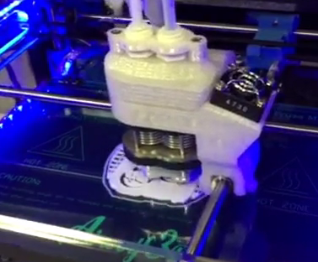Much of the new technology comes to market as the beginning of a larger project. For example, initially, ordinary printers transmitted images to paper in only one color, black, or grayscale. Today, color printers are an affordable and common tool. With 3d printing , it would be no different. Today, 3D color printing exists, although it is still inaccessible to most makers.
Today, 3D printers that create three-dimensional objects from a single filament and therefore have only one color are the most common on the market. Many makers choose, after printing, to paint the created pieces. Others, also inventive, choose different techniques. This article is about these techniques. Learn how you can get color 3D printing with simple home-made techniques.

Color 3D Printing: Filament Swapping
This technique requires first of all experiments by the maker. Relatively simple, filament swapping can be done on virtually any 3D printer using the addition method. For this, the maker must follow some steps:
- Pause the printer when you want to change colors
- Raise the extruder nozzle on the Z-axis by 20mm and clear it
- Position the new filament and melt it until it comes out of the nozzle
- Return the nozzle to its original position and continue printing.
Color 3D printing done with this technique does not allow for much detail, but it is a good choice for those just starting out and not wanting to invest in expensive equipment.
Filament coloring: tie-dye effect
Another way to create a color 3D print is to paint filaments. This technique works best with moisture-absorbing materials such as nylon. Pin shape has a full article on how to paint nylon filaments. In short, the maker can paint the filament with a tie-dye effect by following the steps:
- Remove the filament from the bobbin and wrap it with clamps
- In a saucepan, boil water with the dye
- Immerse the filament in water to the desired height and leave for 30 minutes. Nylon will not melt in boiling water
- Repeat the operation with the other side of the filament in a new color as many times as necessary
- After dyeing the filament, remove excess ink with water
- To dry the nylon, place it in the oven at 150 degrees Celsius for four hours. Remember to remove the clamps.
Painting the filament with tie-dye effect produces beautiful pieces, but does not allow accurate color control or detail detailing. Changing filaments in a single print is a bit cumbersome and yet creates objects with blocks of the same color. While tie-dye printing, while creating interesting effects, leaves the maker virtually no control over the color of the final piece.
Anyway, you don’t have to master 3D to print, there are plenty of free objects online and many of them are extremely well crafted and well explained. But starting modeling with such a printer multiplies the number of possibilities and makes the hobby even more interesting.
You will need some tools to help you perfect your 3D objects
The biggest problem with the adjustments is that once you make all the necessary modifications and model exactly as you had imagined, you may still be sliced into the slicing software and the part misinterpreted by the software. And this is a very common occurrence and a recurring complaint. In the topic below I explain some alternatives to fix this problem.

